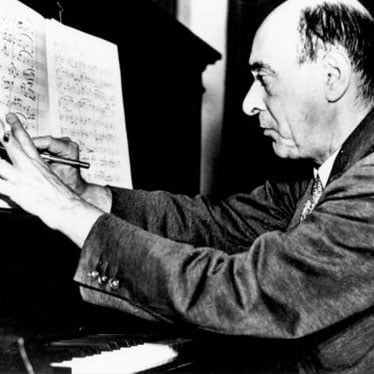Amazing Facts About Arnold Schoenberg

Whether you enjoy his music or not, there is no doubt that Arnold Schoenberg (1874-1951) evokes emotion. The work of this twentieth-century composer and conductor is widely hailed as the progenitor of a radical renovation in modern classical music. His early development of atonality and the latter 12-tone method of composition (a.k.a. serialism) was a turning point in the music timeline, bridging the gap between late Romantic Period style and modern musical expression.
The following amazing facts about Arnold Schoenberg may help you to appreciate why this artist aroused such violent feelings in critics and audiences. Gleaned from his Encyclopedia entry, Fact File, The Famous People record, and his biography at the Arnold Schoenberg Center in Vienna, which is dedicated to his life and work, these facts uncover the genius behind this quintessential modern artist.
- Arnold Schoenberg was born (1874) in Leopoldstadt, a Jewish Ghetto, and is buried in Vienna, although he passed away (1951) in Los Angeles, California.
- Schoenberg’s parents were not musical. They did enjoy listening to music, but were not trained.
- He was primarily self-taught, gathering information where and when he could, starting violin lessons in 1882.
- He stated in his book “Introduction to My Four Quartets” in 1949:
"As a child of less than nine years, I had started composing little, and later large pieces, for two violins, in imitation of such music as I used to play with my teacher or with a cousin of mine. When I could play violin duets of Viotti, Pleyel and others, I imitated their style."
- In addition to composing, conducting, and writing, Schoenberg painted some incredible artwork, including self-portraits. See the collection here.
- In the mid-1900’s, Schoenberg began to teach music privately to select students. Some of his most notable pupils of atonality included Alban Berg, Leon Kirchner, and Anton Webern. It was during this time that he became the leader of the Second Viennese School of music.
- In 1910, he wrote “Harmonielehre,” (Theory of Harmony), and it remains one of the most lasting, influential books he created.
- Schoenberg’s String Quartet No. 2 in F sharp minor, Op. 10 (1908) is largely hailed as one of the first pieces of modern classical music… but its reception was not enthusiastic. The audience and journalists, for the most part, were highly shocked. Although the first two movements reflect Romantic styling, during the third and fourth movements, soprano singer Marie Gutheil-Schoder, incorporates poetry written by Stefan George with very powerful music.
- His creation of serialism (the 12 tone system of composition) in the 1920’s was revolutionary. The concept revolves around a more mathematical approach to music development and is based on arranging a “row" or "series” of the twelve notes on the chromatic scale, in a specific way. The row is then played in various ways, such as inverted, backward, or transposed. The result produces musical unity in a highly logical manner.
- As a Jewish artist, his music was labeled “degenerate” by the rise of the National Socialist Party in Germany. He left Berlin in 1933 and fled to the United States after being excluded from the Prussian Academy by the Nazi political movement. At this time he began teaching in Boston and New York at the Malkin Conservatory.
- That same year (1933), “At the request of Pablo Casals, he composes the Konzert für Violoncello und Orchester (D-Dur), in a free adaptation of the Concerto for Harpsichord of Georg Matthias Monn (completed on 4 January).”
- In 1935, he lectured at the University Southern California and conducted private instruction. Renowned modern composer John Cage became his student at this time.
- In 1936, Arnold Schoenberg was named professor at the University of California at Los Angeles (in 1944 he would be named professor emeritus), and moved to “Brentwood Park, West Los Angeles, where he lives for the remainder of his life.” He also “befriends” George Gershwin this year.
- In 1939, he spent much of his energy and efforts trying to get family and friends out of Europe in order to escape the genocide created by the socialist party. His son Georg’s family spent the war in Mödling.
- By 1949, his failing health prevented him from traveling to Vienna to attend the celebration his 75th birthday; he was named “citizen of the City of Vienna.”
- On the year of his death, 1951, he was named Honorary President of the Israeli Academy of Music in Jerusalem.
Arnold Schoenberg lived his life in the pursuit of his artistic expression. Although his music was largely misunderstood, because he persevered, his inspiration altered the course of classical music composition. Learn more about this incredible artist by visiting the website for the Arnold Schoenberg Center, or if you can, visit it in the beautiful city of Vienna.


